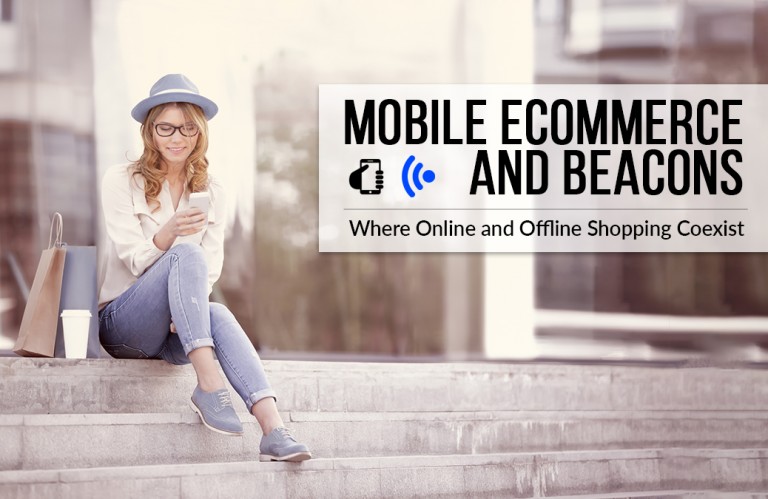

GET MARKETING INSIGHTS TO GROW YOUR AMAZON BUSINESS
– MARKET SHARE
– COMPETITOR INSIGHTS
– PRODUCT CATEGORY POTENTIAL & A LOT MORE!
Mobile Ecommerce and Beacons: Where Online and Offline Shopping Coexist


Beacons offer a relatively new and innovative way for retailers to communicate with customers through their mobile devices, bringing online and offline shopping together. While online shopping is continually growing, most retailers are omni-channel; beacon technology helps to bridge the gap between the various shopping channels for a highly personalized experience.
Apple was the first company to bring beacon technology mainstream with iBeacon. Apple’s iBeacon is built into its devices and iOS7 mobile operating system, however third party manufacturers have built beacons that can send iBeacon messages to Apple devices. Estimote and Kontakt are a few popular beacon manufacturers.
All modern smart devices are capable of supporting beacons (iPhones, Android, Windows and Blackberry) as long as Bluetooth is turned on. Beacons communicate wirelessly with devices using Bluetooth Low Energy (BLE) signals, a version of Bluetooth that uses very little power and transmits small amounts of data. Beacons are tiny, battery-operated, low-cost hardware devices that attach to walls or physical objects and transmit signals directly to a smartphone or tablet. They are solely one-way transmitters that require the user’s device to have the brand’s application installed. Since users must have a specific application downloaded on their phone, beacons are most powerful when the retailer and customer already have an existing relationship.
Beacons are location-based tools and transmit signals to smartphones and tablets that fall within a certain range. Standard beacons have a range of 70 meters with no obstructions. A smart device constantly scans for their signals and if it’s within a beacon’s proximity, the installed app responds by displaying personalized advertising content as a notification or directly in the app. This allows for highly contextual, hyper-local, and meaningful messages and advertisements to be sent directly to consumers. Since the consumer’s phone must be nearby to receive these signals, beacon technology appeals most to retailers with physical locations.
85 percent of the top 100 retailers in the US will have deployed at least some beacons by the end of 2016 and beacon technology will have influenced over $44.4 billion worth of retail sales, a staggering increase from 4.1 billion in 2015.
A few benefits of using beacons are:
- Greet and Guide Customers. Signals allow the app to know when a customer is getting closer or further away. This gives retailers the opportunity to identify and engage a customer with hello or goodbye, or an invitation into the store. Even if the app isn’t running, beacons can wake it up.
- Engage customers with relevant information. Retailers can send out location-specific deals, discounts, coupons and recommendations to consumers in the store. This makes it easier for stores to share contextual information like special sales or product information when consumers are close to a particular item or display.
- Enhanced in-store experience. Beacons help personalize the shopping experience, especially if a store is crowded or salespeople aren’t available. They let consumers find relevant information quickly, get new information based on location as they walk around, and receive personalized offers based on previous purchases. They also simplify and ease checkout processes, allow for digital payments and receipts, and much more.
- Beacons and loyalty apps. Retailers can use these together to reward customers for all types of location-based actions, even just walking into a store.
- Provide insight into customer behaviour and build loyalty. Businesses can learn about footfall patterns, entry and exit data, time spent, repeat visits, purchase history and other customer data that can be analyzed to improve the customer’s overall shopping experience. Beacons can send or collect information from devices, allowing retailers to deliver a rich and targeted shopping experience.


Some examples of retailers who’ve jumped onto the beacon craze are:
- Macy’s teaming up with the Shopkick app and sending customers location-specific deals, discounts, and recommendations
while in their stores. The test was a huge success, leading them to install over 4000 iBeacon devices nationwide. - Urban Outfitters took a different approach from more commonly used aggressive promotions. They used their own app with the beacons plugged into the Urban On loyalty program, a section that gives shoppers rewards and access to events. They also focused on using beacons in three in-store areas: the checkout line, fitting rooms and the entrance.
- Beacons are also popular in stadiums and airports to help with things like food sales, check in and navigation.
Check out these other retail examples.
It’s worth noting that beacons can only operate/talk in one direction. This means they can broadcast data but cannot read things off your phone. In short, beacons don’t track you, your smartphone tracks the beacon.
A great resource for brick-and-mortar stores, beacons are a cost-effective way to drive customer engagement and connect in-store and ecommerce shopping. A consumer might walk down an aisle with a digital storefront, pass a particular display and be directed to an online portal with discounts or cross-sell opportunities. Online and offline shopping begin to coexist at this point, delivering the ultimate retail experience.
Beacons make a great location-based marketing tool for engaging customers in a personalized way and gaining customer insights. Make sure you deploy them effectively, however, by offering targeted content that encourages customer loyalty. It’s a fine line between engaging customers and alienating them with too many push notifications and pesky messages.
